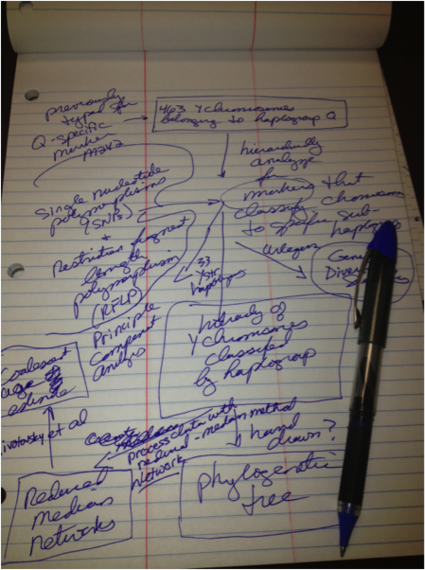How to Read Through Research Article First Read
To form a truly educated opinion on a scientific subject, yous demand to go familiar with current research in that field. And to exist able to distinguish between good and bad interpretations of research, you accept to be willing and able to read the principal research literature for yourself. Reading and understanding research papers is a skill that every single dr. and scientist has had to acquire during graduate school. You tin can learn it too, but like any skill information technology takes patience and practice.
Reading a scientific paper is a completely different process from reading an article about scientific discipline in a blog or paper. Not only do you read the sections in a different gild than they're presented, just you lot also have to take notes, read information technology multiple times, and probably go look up other papers in order to empathise some of the details. Reading a unmarried newspaper may have y'all a very long time at first, but be patient with yourself. The process volition go much faster as you gain experience.
The type of scientific paper I'm discussing here is referred to as a primary research article. It'southward a peer-reviewed report of new research on a specific question (or questions). Well-nigh articles volition be divided into the following sections: abstract, introduction, methods, results, and conclusions/interpretations/discussion.
Before y'all begin reading a paper, take note of the authors and their institutional affiliations. Some institutions (eastward.g., University of Texas) are well-respected; others may appear to exist legitimate research institutions simply are actually agenda-driven. Too have notation of the journal in which it's published. Be cautious of articles from questionable journals, or sites like Natural News, that might resemble peer-reviewed scientific journals simply aren't.
Stride-past-Step Instructions for Reading a Primary Research Article
i. Begin past reading the introduction, not the abstract.
The abstract is that dense showtime paragraph at the very showtime of a paper. In fact, that's often the only part of a paper that many not-scientists read when they're trying to build a scientific argument. (This is a terrible exercise. Don't do it.) I always read the abstruse terminal, because information technology contains a succinct summary of the unabridged paper, and I'one thousand concerned near inadvertently becoming biased by the authors' interpretation of the results.
ii. Identify the big question.
Not "What is this newspaper about?" but "What problem is this entire field trying to solve?" This helps you focus on why this research is being done. Expect closely for prove of agenda-motivated research.
iii. Summarize the background in five sentences or less.
What work has been done before in this field to answer the big question? What are the limitations of that work? What, according to the authors, needs to exist done next? You lot need to be able to succinctly explain why this research has been done in order to sympathise information technology.
4. Place the specific question(southward).
What exactly are the authors trying to respond with their research? There may be multiple questions, or only one. Write them down. If it's the kind of research that tests one or more than aught hypotheses, identify it/them.
five. Identify the approach.
What are the authors going to exercise to respond the specific question(southward)?
6. Read the methods section.
Depict a diagram for each experiment, showing exactly what the authors did. Include as much item as you demand to fully understand the work.

7. Read the results section.
Write ane or more paragraphs to summarize the results for each experiment, each figure, and each table. Don't yet try to determine what the results mean; but write down what they are. You lot'll often observe that results are summarized in the figures and tables. Pay careful attention to them! You may besides demand to go to supplementary online information files to detect some of the results. Also pay attending to:
- The words "significant" and "non-pregnant." These have precise statistical meanings. Read more than nearly this here.
eight. Determine whether the results respond the specific question(due south).
What practice y'all recollect they hateful? Don't move on until yous accept thought about this. It's OK to alter your heed in light of the authors' interpretation -- in fact, you probably will if you're nonetheless a beginner at this kind of assay -- but it'southward a really proficient habit to start forming your ain interpretations earlier yous read those of others.
ix. Read the decision/give-and-take/interpretation section.
What do the authors recollect the results hateful? Exercise you concur with them? Tin you come up with any culling fashion of interpreting them? Exercise the authors identify whatever weaknesses in their own study? Exercise you run into whatsoever that the authors missed? (Don't assume they're infallible!) What do they advise to do as a next stride? Do you concur with that?
10. Go dorsum to the beginning and read the abstract.
Does it match what the authors said in the newspaper? Does information technology fit with your estimation of the newspaper?
11. Find out what other researchers say near the newspaper.
Who are the (acknowledged or self-proclaimed) experts in this particular field? Do they have criticisms of the written report that y'all haven't idea of, or exercise they generally support it? Don't fail to practice this! Here's a place where I do recommend you use Google! But do it last, so y'all are better prepared to think critically about what other people say.
A total-length version of this post originally appeared on the author's personal blog.
Source: https://www.huffpost.com/entry/how-to-read-and-understand-a-scientific-paper_b_5501628
0 Response to "How to Read Through Research Article First Read"
Post a Comment